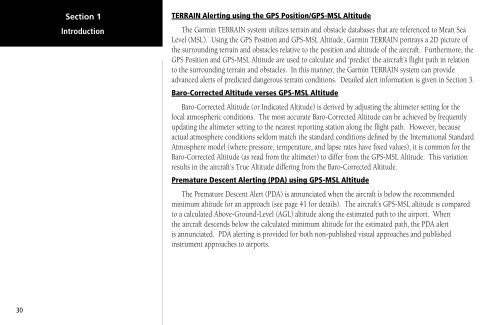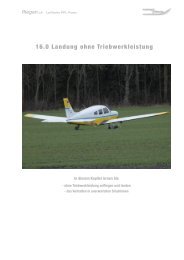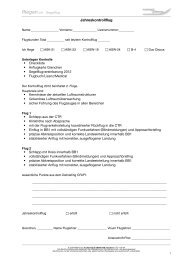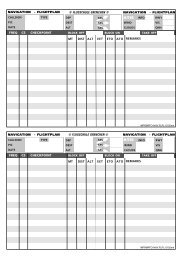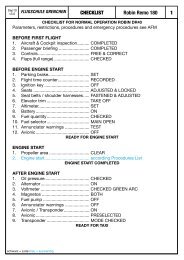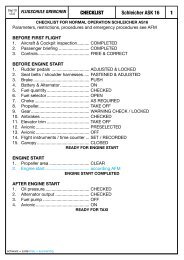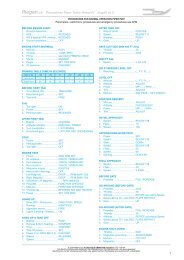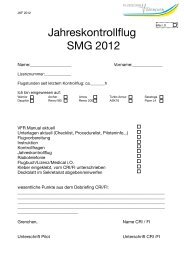400/500 Series Garmin Optional Displays
400/500 Series Garmin Optional Displays
400/500 Series Garmin Optional Displays
You also want an ePaper? Increase the reach of your titles
YUMPU automatically turns print PDFs into web optimized ePapers that Google loves.
30<br />
Section 1<br />
Introduction<br />
TERRAIN Alerting using the GPS Position/GPS-MSL Altitude<br />
The <strong>Garmin</strong> TERRAIN system utilizes terrain and obstacle databases that are referenced to Mean Sea<br />
Level (MSL). Using the GPS Position and GPS-MSL Altitude, <strong>Garmin</strong> TERRAIN portrays a 2D picture of<br />
the surrounding terrain and obstacles relative to the position and altitude of the aircraft. Furthermore, the<br />
GPS Position and GPS-MSL Altitude are used to calculate and ‘predict’ the aircraft’s flight path in relation<br />
to the surrounding terrain and obstacles. In this manner, the <strong>Garmin</strong> TERRAIN system can provide<br />
advanced alerts of predicted dangerous terrain conditions. Detailed alert information is given in Section 3.<br />
Baro-Corrected Altitude verses GPS-MSL Altitude<br />
Baro-Corrected Altitude (or Indicated Altitude) is derived by adjusting the altimeter setting for the<br />
local atmospheric conditions. The most accurate Baro-Corrected Altitude can be achieved by frequently<br />
updating the altimeter setting to the nearest reporting station along the flight path. However, because<br />
actual atmosphere conditions seldom match the standard conditions defined by the International Standard<br />
Atmosphere model (where pressure, temperature, and lapse rates have fixed values), it is common for the<br />
Baro-Corrected Altitude (as read from the altimeter) to differ from the GPS-MSL Altitude. This variation<br />
results in the aircraft’s True Altitude differing from the Baro-Corrected Altitude.<br />
Premature Descent Alerting (PDA) using GPS-MSL Altitude<br />
The Premature Descent Alert (PDA) is annunciated when the aircraft is below the recommended<br />
minimum altitude for an approach (see page 41 for details). The aircraft’s GPS-MSL altitude is compared<br />
to a calculated Above-Ground-Level (AGL) altitude along the estimated path to the airport. When<br />
the aircraft descends below the calculated minimum altitude for the estimated path, the PDA alert<br />
is annunciated. PDA alerting is provided for both non-published visual approaches and published<br />
instrument approaches to airports.


